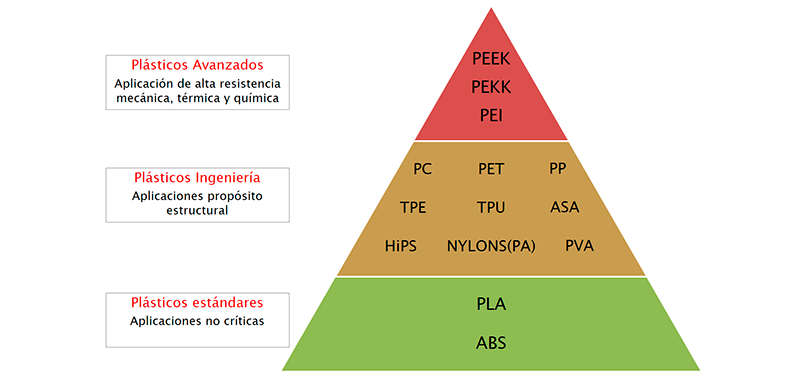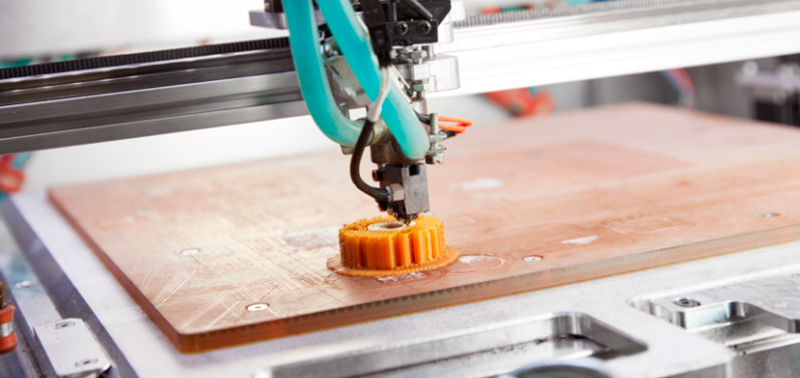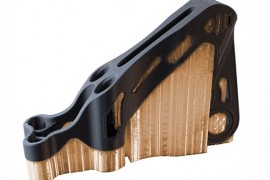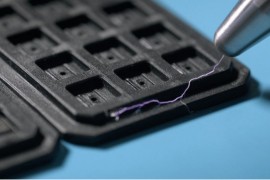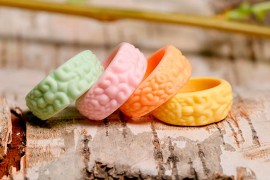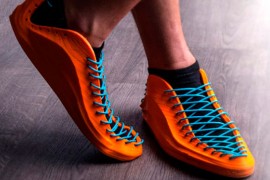
Plastic materials can be classified into 3 groups: standard, engineering and advanced plastics.
Advanced plastics are known as PAEK (polyaryl ether ether ketone), semi-crystalline plastics that withstand high temperatures while retaining mechanical properties.
Image 1: Plastics classification pyramid. Source: Filament2print.
Within the PAEK family there are three types: PEEK, PEKK and PEI, all with high chemical and mechanical resistance and high temperature flammability. Among these three materials, PEI stands out from the rest due to its dimensional stability, which gives it high thermal resistance without changing its mechanical properties.
PEI is often used in applications where thermal resistance and high pressure values are a must, such as injection moulding. Making injection moulds by 3D printing reduces manufacturing costs and speeds up the prototyping process, making it quicker and easier to produce results. One of the filaments that stands out for this activity is Ultem 1010.
To 3D print a filament such as Ultem 1010, it is necessary to use an industrial 3D printer that reaches a printing temperature of more than 400 ͒C, a hot bed temperature of at least 150 ͒C and a chamber temperature of at least 80 ͒C.
A few years ago it was difficult to think that a prototype of a part could be reproduced in just a few hours and with exceptional finishes and quality. The integration of 3D printing into the industrial production process has been slow, due to the existing limitations in terms of production volume and the scarcity of technical materials to work with. Today, FDM 3D printing is an indispensable tool in industry and is accessible to any user who wants to expand their knowledge and skills in this manufacturing method.
In the production of FDM 3D printed parts for industry, it is often necessary to manufacture parts with complex geometries that may require support structures to support areas with overhangs or steep angles. When 3D printing a part with supports, the same build material can be used. These supports must be removed after completion of the 3D printing process. In these cases, caution should be exercised when removing them, as this may damage the final part. Likewise, after the support structures have been removed, post-processing must be carried out to leave the surface of the part free of excess material in order to obtain a surface that is as uniform as possible.
Image 2: 3D printed turbine with and without support material. Source: Infinite material solution.
To facilitate the FDM 3D printing process of parts with complex geometries, various soluble support materials have been developed (either in substances such as D-Limonene or in water) compatible with different materials such as PLA, PETG or ABS among others, but not valid for use in combination with advanced filaments such as PEEK, PEKK or PEI Ultem due to their high printing temperature.
Infinite material solutions is an American company founded in 2018, dedicated to the development of innovative materials for FFF 3D printing. In November 2020 Infinite material solutions launches AquaSys 180, a soluble support material designed to withstand high temperatures.
Image 3: 3D printing process with AquaSys 180. Source: Infinite material solutions.
AquaSys 180 is the first soluble support material compatible with advanced materials, withstanding printing temperatures up to 300 ͒C and base and chamber temperatures up to 180 ͒C. Thanks to the thermal resistance of AQUASYS 180, this filament can be used as a soluble support material in combination with advanced materials such as PEEK, PEKK, ULTEM or PPSU, offering greater design freedom and flexibility for the industrial sector.
Thanks to the research of manufacturers such as Infinite material solutions and their drive to develop new advanced products such as AquaSys 180, the industrial sector has more and more resources available for the manufacture of parts using FDM 3D printing.

